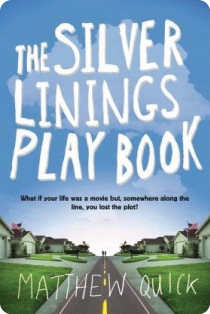Books |
The Silver Linings Playbook
Matthew Quick
By
Published: Nov 08, 2012
Category:
Fiction
This is a little film — a relationship film: no car chases, no special effects — about two damaged people who find each other, mess each other up, heal each other.
It stars Jennifer Lawrence (best known for "The Hunger Games," a favorite of kids who will have no interest in this story) and Bradley Cooper (late of "The Hangover," a movie for guys who won’t have much interest in this story), with support from Robert De Niro.
It won festivals.
It outearned "bigger" movies.
It might just win an Academy Award.
And maybe not just one.
Why? Watch:
You might also like to read the novel.
The novel of "Silver Linings Playbook" reads like the wind. I finished it in two-and-a-hours. My fingers got a little tired flipping the pages; you may want to go Kindle. [To buy the paperback from Amazon, click here. For the Kindle edition, click here.]
What’s the appeal?
First, the set-up: damaged people who want to get better. Who can’t relate? We are, all of us, damaged.
Next, the simple story line. There’s a goal. There’s conflict. The key ingredients in all great drama.
And then it’s witty.
Like this: Pat Peoples is just making his way out of a “neural health facility” after what he thinks is a four-month stay. He’s studying American fiction — doom-ridden books like “The Bell Jar” and “The Great Gatsby” and "A Farewell to Arms” — because his estranged wife, Nikki, is an English teacher who has put them on her reading list. As he explains:
I’m going to read all the novels on her American literature class syllabus, just to make her proud, to let her know that I am really interested in what she loves and I am making a real effort to salvage our marriage, especially since I will now be able to converse with her swanky literary friends, saying things like, “I’m thirty. I’m five years too old to lie to myself and call it honor,” which Nick says toward the end of Fitzgerald’s famous novel, but the line works for me too, because I am also thirty, so when I say it, I will sound really smart. We will probably be chatting over dinner, and the reference will make Nikki smile and laugh because she will be so surprised that I have actually read “The Great Gatsby”. That’s part of my plan….
Pat believes that what he’s been experiencing is “away time” — time he needs to become a better person, so he’ll be worthy of being with Nikki. (Right now, she has an order of protection to keep him at a safe distance.) He searches the sky for cloud formations. (Doesn’t even the darkest cloud have a silver lining?) And he absolutely believes in happy endings. (Why else would he exercise all day, lose 50 pounds, turn himself into a Greek statue, if not to be reunited with his wife?)
Of course "The Silver Linings Playbook" has a happy ending — a first novelist doesn’t struggle for years to explore a theme like happiness and then tack on a tricky, sad ending. (Note: the happy ending may not be the ending you may expect.) But the pleasure of the book isn’t the destination. It is, as not overly bright actresses say in Academy Award speeches, the journey.
And what a journey! Even though he’s medicated, even though he’s a professional patient, it doesn’t take much to set Pat off — a few notes of a Kenny G sax solo, and he’s ready to tear the room apart. So getting back with his wife is the least of it; living in what the rest of us call reality is the big challenge.
As the novel opens, Pat’s mother springs him from the institution. And, right away, the battle with reality begins. His father, a hardcore football fan, won’t talk to Pat, not even about their shared obsession, the Philadelphia Eagles. At a set-up dinner, he meets Tiffany, who promptly offers to sleep with him. And every time he leaves his parents’ home, he enters a world that’s not likely to be friendly.
But Pat’s is not a harrowing story — "The Silver Linings Playbook" is kind of a romp. Take “One Flew Over the Cuckoo’s Nest,” change the main character from an attitude case to a man who really wants to make his life work, and you’ve got some of the charm of Pat. Matthew Quick understands this guy and presents him squarely, with none of the special pleading that a lesser writer might employ.
Small characters. Small story. Big impact.
BONUS VIDEO


